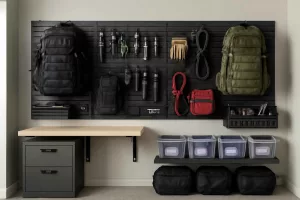Maintaining a well-organized workshop starts with keeping your power tool batteries in check. A dedicated DIY power tool charging station not only streamlines your workflow but also protects your batteries from damage. In this guide, you’ll learn how to design and build a mobile battery charging cart that holds multiple batteries and chargers in one convenient place. With a compact footprint and wheels for easy maneuvering, this cart will become the heart of your DIY Rolling Tool Cart with Power Strip setup and ensure you never run out of power mid-project. Kickstart your build with a versatile cordless tool charging station to see how a purpose-built charging area elevates productivity.
Why You Need a DIY Power Tool Charging Station
A growing collection of cordless drills, impact drivers, saws and other cordless tools can quickly become a charging nightmare. Chargers scattered across benches lead to lost batteries, tangled cords, and inefficient use of workspace. A dedicated DIY power tool charging station solves these problems by:
- Centralizing all chargers and batteries in one mobile unit.
- Helping you track battery charge status at a glance.
- Preventing battery over-discharge and heat damage.
- Reducing clutter and freeing up bench space for active projects.
By building your own workshop charging station, you also save on pre-built solutions that may not match your tool ecosystem or workshop layout. Plus, a DIY cart adapts to changes in your collection as you grow your library of cordless tools.
Planning Your Mobile Charging Cart
Before cutting wood, use a sketch or digital plan to determine the dimensions and features you need. Consider these factors during the planning phase:
Cart Footprint and Mobility
Measure the space where you’ll store the cart. A 24″ by 18″ footprint is compact enough for tight workshops but still offers room for up to six chargers. Install four heavy-duty caster wheels—two locking—to ensure the cart is both mobile and stable when parked.
Number of Charging Stations
Inventory all your cordless tools and count the chargers required. Factor in future purchases by adding one or two extra slots. Design the top shelf to securely hold charger bases, allowing proper ventilation and cord routing underneath.
Power Management
Incorporate a power strip or outlet box into the cart. Hardwiring a multi-outlet surge protector under the top shelf keeps cords hidden and organized. Make sure you choose a surge protector rated for tool chargers to protect against voltage spikes.
Battery Storage and Organization
Below the top shelf, design compartments or slots for discharged batteries waiting to charge, and another for fully charged batteries ready for use. Label each section or use color-coded bins for quick identification.
Materials and Tools Required
Gathering quality materials ensures your charging station is sturdy and safe. You’ll need:
- 3 sheets of 3/4″ cabinet-grade plywood (2’x4′) for shelves and dividers.
- 1×2 solid wood strips for shelf framing.
- 4 heavy-duty caster wheels (two with locks).
- 1 metal power strip mount or outlet box with integrated surge protector.
- Wood screws (1 1/4″ and 2 1/2″).
- Power drill, screwdriver bits, and countersink bit.
- Jigsaw or circular saw for cutting plywood.
- Clamps for gluing and assembly.
- Sandpaper (120 and 220 grit) and wood finish of choice.
- Wire ties or cord organizers to manage cables.
Optional accessories enhance functionality:
- Small bins or drawer slides for battery storage.
- Rubber mat liners for shelves to reduce slippage.
- Labels or a label maker to mark battery types.
Step-by-Step Building Instructions
This section walks you through constructing a sturdy and organized DIY battery charging station. Each step includes tips to maintain precision and safety.
1. Cutting and Preparing Shelves
Trace and cut two pieces of plywood for the top and middle shelves to your chosen footprint (e.g., 24″×18″). Use a circular saw with a straightedge guide to ensure square cuts. Sand edges smooth to prevent splinters. Apply a protective finish if desired—this helps resist oil and dirt from batteries.
2. Framing the Shelf Edges
Attach 1×2 solid wood strips around the shelf perimeters. These framing strips add rigidity and keep chargers and batteries from sliding off. Predrill pilot holes and countersink screws for a flush finish. Clamp the strips before fastening to avoid misalignment.
3. Building the Support Frame
Use 2×2 or 2×3 lumber to construct the vertical supports and bottom shelf frame. Cut four legs to your desired height (e.g., 30″ for waist-level access). Join legs with cross braces using pocket holes or metal brackets for strength. Attach the middle shelf frame at half-height to support the lower battery storage section.
4. Mounting the Power Strip
Under the top shelf, secure your surge protector or outlet box using its mounting bracket. Route cords through holes drilled in the plywood and fasten them with grommets to protect against abrasion. Use wire ties to bundle and route cables neatly down the cart’s leg channel to prevent any tripping hazard.
5. Installing Battery Slots and Dividers
Create vertical dividers on the lower shelf to form individual battery slots. Cut plywood strips to match the shelf depth and attach them at even intervals using glue and finishing nails. Leave enough space for battery packs to slide in and out easily. Line each slot with a rubber shelf liner for grip.
6. Attaching Casters and Final Assembly
Flip the assembled cart upside down and mount the four caster wheels at each corner. Ensure two locking wheels are oriented on the same side for stability. Double-check that the cart sits level before tightening all fasteners. Flip it right-side up and roll it through your workspace to confirm smooth movement.
Organizing and Maintaining Your Charging Station
With your battery charging cart complete, follow these tips to keep it optimal:
- Rotate batteries regularly: Move fully charged batteries to the ready section and place discharged ones into charging slots immediately.
- Monitor battery health: Refer to our how to extend the life of power tool batteries guide for best practices on charging cycles and storage conditions.
- Keep contacts clean: Wipe charger and battery contacts with a dry cloth to maintain efficient charging and prevent corrosion.
- Secure cords: Every week, verify that cables and cords are free of frays and properly tied to prevent tangles.
- Clean surfaces: Wipe down shelves and bins to remove dust and debris that can interfere with charging vents.
Safety Tips and Best Practices
Building and using a DIY charging station involves electrical components and heavy materials. Prioritize safety by following these recommendations:
- Wear safety glasses and hearing protection when cutting wood.
- Unplug chargers before installing or adjusting them on the cart.
- Use a surge protector designed for power tools to guard against voltage spikes.
- Never overload the power strip: check the total amp draw of chargers and keep it within rated limits.
- Position the cart away from water sources and flammable materials.
- Test the locking casters before placing heavy batteries on the cart.
Conclusion
A DIY power tool charging station brings order, safety and efficiency to any workshop. By centralizing your chargers and batteries on a mobile cart, you free up bench space and avoid the frustration of misplaced batteries. Follow this detailed guide to tailor your cart to your tool collection, and enjoy the convenience of having every battery right where you need it—fully charged and ready to go. Ready to upgrade your workshop? Grab a battery charging station accessory pack to complement your build and keep your projects powered up.






